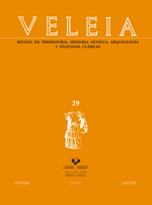Form vs. fonction in Prehistoric Typology: The Case of the Magdalenian Bone Bull-roarers
##plugins.themes.bootstrap3.article.main##
##plugins.themes.bootstrap3.article.sidebar##
Abstract
In 1930, an archaeological evidence worked on antler was recovered by D. Peyrony in the Upper Magdalenian level of Lalinde's cave (Dordogne), and was interpreted as a 'churinga' or bull-roarer. The shape of this holotype is fusiform, elongated and narrow, and with a hole in one end. Ever since then, the new evidences recovered (preferably on ribs of animals) in Western Europe (north of Iberian Peninsula, north Pyrenees and Dordogne) have been scarce. The author describes the bull-roarer or rhombus, and other types with related shapes (such as the ellipse and pendants). Besides, the author puts forward the difficulties of the classification of Paleolithic bone/antler (and, also, lithic) tools, which are based often on the convergence of formal characteristics and assumptions about the use of the tools.
##plugins.themes.bootstrap3.article.details##
Unless otherwise noted, the contents of the electronic edition of the OJS platform are licensed for use and distribution under a Creative Commons Attribution-NonCommercial-NoDerivatives 4.0 International (CC-BY-NC-ND) license.
The journal does not charge any financial compensation to authors for publishing in it and provides full access to the archives without any kind of embargo from the day of electronic publication. This respects the national open access policy.
All originals published in the journal Veleia, whether in print or digital format, are the property of the University of the Basque Country (UPV/EHU). © UPV/EHU
Authors of articles (whether research articles, news articles, news items or reviews) will be able to access their own work on the Journal's website. Authors will be able to put them in their personal repositories and will also have the possibility of pre-print dissemination of articles accepted for publication.

